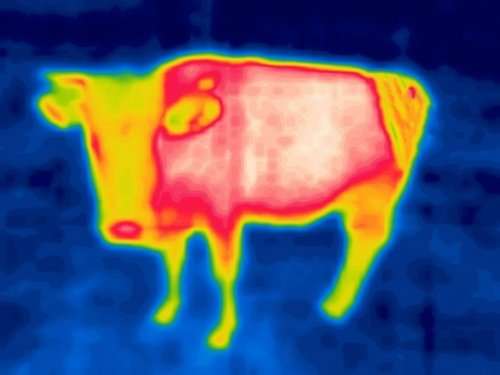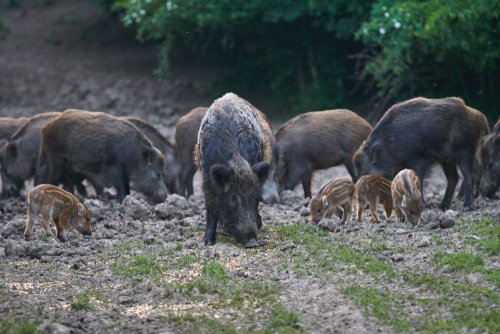Beyond Night Vision: Exploring the Benefits of Thermal Imaging
When it comes to hog hunting, one of the most effective tools in a hunter’s arsenal is thermal imaging technology. Thermal imaging in hog hunting has continued to gain popularity. This cutting-edge technology has revolutionized the way hunters track and locate hogs, providing an unmatched advantage in their pursuit.
In this article, we will delve into the world of thermal imaging in hog hunting, exploring its basics, the devices used for tracking hogs, and the advantages it offers to hunters. To fully understand the significance of thermal imaging in hog hunting, it is essential to grasp the fundamentals of this remarkable technology.
Thermal imaging operates on the principle of detecting and capturing infrared radiation emitted by objects based on their temperature differences. By utilizing specialized sensors and algorithms, thermal imaging devices are capable of creating detailed images that display heat signatures rather than relying on visible light like traditional optics do.
The advantages of thermal optics in hog hunting are numerous. Firstly, they allow hunters to track game with greater efficiency during low light conditions or even complete darkness.
Unlike traditional optics that heavily depend on ambient light sources such as moonlight or artificial illumination, thermal imaging devices can detect heat signatures regardless of lighting conditions. This makes them invaluable tools for nocturnal hunts or when pursuing hogs that are active during twilight hours.
Furthermore, tracking with thermal imaging provides hunters with an unprecedented level of stealth and concealment. By relying solely on heat signatures instead of visual cues like movement or coloration, hunters can maintain a safe distance from their prey while remaining undetected.
This is particularly advantageous when dealing with feral hogs known for their acute senses and wariness towards human presence. Thermal imaging technology has proven itself as a game-changer in hog hunting endeavors.
Its ability to detect and visualize heat signatures enables hunters to efficiently track hogs at any time of day or night while maintaining a covert approach. In the following sections of this article, we will explore different types of thermal imaging devices designed specifically for hog tracking and delve into the techniques that maximize success in hog hunting using this innovative technology.
The Basics of Thermal Imaging Technology
Thermal imaging technology has revolutionized hog hunting, offering hunters a distinct advantage in tracking and locating these elusive creatures. Understanding the basics of thermal imaging technology is critical for hunters seeking to maximize their success in the field.
At its core, thermal imaging relies on the detection of infrared radiation emitted by objects. Every object with a temperature above absolute zero emits infrared radiation, and thermal imaging devices capture this radiation to create detailed images.
Unlike traditional night vision optics that rely on available light, thermal optics can work day or night, as they detect heat signatures rather than visible light. One of the key advantages of thermal optics is their ability to detect heat signatures through various obstacles such as foliage and atmospheric conditions like fog or smoke.
This allows hunters to track hogs even in low-light conditions or areas with dense vegetation where visibility is limited. Thermal imagers convert the collected radiation into a visual representation known as a thermogram, where different temperatures are displayed using different colors or shades.
Thermal imaging devices often feature different color palettes that allow hunters to customize their viewing experience based on personal preference and environmental conditions. Common color palettes include “white hot,” where hotter objects appear white and cooler objects appear black; “black hot,” which reverses this color scheme; and “rainbow,” which displays a range of colors based on temperature intensity.
The ability to customize these color palettes enhances visibility and aids in spotting hogs against various backgrounds. Understanding the basics of thermal imaging technology is essential for hog hunters looking to leverage its advantages in tracking elusive game.
By detecting heat signatures emitted by hogs irrespective of lighting conditions or obstacles, thermal optics provide hunters with an invaluable tool for increased success in hog hunting expeditions. Additionally, being familiar with different color palettes allows hunters to optimize their viewing experience further and enhance their chances of spotting hogs against diverse backgrounds.
Thermal Imaging Devices for Hog Tracking
When it comes to hog hunting, having the right equipment is crucial for success. In recent years, thermal imaging technology has revolutionized the way hunters track hogs.
These devices utilize infrared radiation to create detailed images of heat signatures, allowing hunters to detect hogs even in complete darkness or dense cover. Several different types of thermal imaging devices are available on the market today, each with its own unique features and capabilities.
One popular option for hog tracking is a handheld thermal monocular. These compact devices are lightweight and offer excellent portability, making them ideal for hunters on the move.
Equipped with high-resolution sensors and advanced image processing algorithms, these monoculars provide clear and crisp images of hogs at various distances. With features like adjustable focus and digital zoom, hunters can easily spot their targets from afar, giving them a significant advantage in the field.
For those who prefer a more hands-free approach, helmet-mounted thermal goggles are an excellent choice. These goggles provide a comfortable fit while offering a wide field of view, allowing hunters to scan their surroundings effortlessly.
With built-in features such as image enhancement and color palettes optimized for wildlife detection, these goggles enhance tracking efficiency in various hunting conditions. Additionally, some models can be connected to external displays or recording devices for easy sharing of footage or analysis after the hunt.
Another popular option among hog hunters is the rifle-mounted thermal scope. These scopes combine traditional rifle optics with cutting-edge thermal imaging technology to provide precise targeting capabilities day or night.
With features like ballistic reticles and range finders integrated into the display, these scopes significantly improve accuracy and shot placement during nighttime hunts. By tracking hogs through the crosshairs on a vivid thermal image display, hunters can make confident shots even in challenging scenarios.
When it comes to tracking hogs with thermal imaging technology, there is a variety of devices available to suit every hunter’s preference. Handheld thermal monoculars offer portability and ease of use, helmet-mounted thermal goggles provide a hands-free experience with a wide field of view, and rifle-mounted thermal scopes combine traditional optics with precise thermal imaging capabilities.
The advantages of these thermal devices in hog hunting cannot be overstated, as they offer hunters the ability to detect hogs in complete darkness or thick cover where traditional optics fall short. With the right thermal imaging device in hand, hog hunters can significantly enhance their tracking abilities and increase their chances of a successful hunt.
Advantages of Tracking Hogs with Thermal Imaging
Thermal imaging technology has revolutionized the way hogs are tracked, providing hunters with a distinct advantage over traditional methods. The use of thermal optics in hog hunting offers several key benefits that enhance overall success rates and efficiency.
Firstly, one major advantage is the ability to track hogs in total darkness. Unlike traditional methods that heavily rely on daylight or moonlight, thermal imaging allows hunters to spot and track hogs regardless of the time of day or prevailing lighting conditions.
This is particularly advantageous as hogs are notorious for being predominantly active during the cover of darkness, making them difficult to locate using conventional tracking techniques. Additionally, thermal imaging enables hunters to detect hidden or camouflaged hogs with greater ease.
Hogs possess an exceptional ability to blend into their surroundings, making them incredibly elusive targets. However, with the use of thermal optics, these cunning creatures cannot escape detection easily.
The technology allows for clear differentiation between the heat signature emitted by a hog’s body and its surrounding environment. Consequently, hunters can effortlessly identify even well-hidden hogs lurking in dense vegetation or brush.
Furthermore, tracking with thermal imaging provides real-time updates on hog movement patterns and behaviors. Traditional tracking methods often rely on footprints, signs of rooting, or disturbed vegetation to determine hog activity; however, this can be time-consuming and unreliable.
Thermal optics offer a distinct advantage by allowing hunters to observe live video feeds or images that clearly depict hog movements in real-time. By monitoring these visual cues closely while utilizing advanced tracking techniques such as stalking or ambush tactics strategically, hunters can significantly increase their chances of successful harvests.
The advantages offered by thermal imaging in hog hunting are significant and cannot be overstated. The ability to track hogs regardless of lighting conditions combined with enhanced visibility in dense cover provides unparalleled advantages for hunters using this technology.
Furthermore, having access to real-time video feeds depicting hog movements allows for more informed and precise hunting strategies. As thermal imaging continues to advance, it undoubtedly remains a game-changer in the world of hog hunting, facilitating greater success rates and enhancing overall hunting experiences for enthusiasts worldwide.
Techniques for Successful Hog Tracking with Thermal Imaging
Successful hog tracking with thermal imaging requires a combination of effective techniques and keen observation skills. Here, we will explore some tried and tested methods to maximize your tracking success using thermal optics. Firstly, it is crucial to understand the behavior patterns of hogs.
These creatures are primarily nocturnal, meaning they are most active during the night. Capitalizing on this knowledge, tracking should ideally take place after sunset or before sunrise when the hogs are most active.
Additionally, it is important to consider factors such as wind direction and noise level when planning a successful tracking expedition. Hogs have an acute sense of smell and hearing, so approaching from downwind while minimizing noise will increase your chances of getting close enough for an accurate shot.
Once you have identified a group of hogs using thermal imaging, employing proper stalking techniques becomes essential. The art of stealthily closing the distance between yourself and the target requires patience and careful movement.
Take advantage of natural cover like trees or bushes to mask your approach while using thermal imaging to monitor the movements of the hogs. When necessary, move slowly and deliberately, avoiding sudden movements that could alert the hogs or compromise your position.
Another effective technique for successful hog tracking with thermal imaging is identifying key locations where hogs are likely to congregate or pass through regularly. These areas include bedding sites, watering holes, feeding grounds, or well-worn trails used by herds.
By studying their behavior patterns and analyzing past observations through thermal imagery data collected in similar conditions, you can strategically position yourself for optimal encounters with these elusive creatures. Mastering effective techniques for hog tracking with thermal imaging is key in maximizing your hunting success rate.
Understanding hog behavior patterns is vital when planning your hunting excursion around their nocturnal nature and taking into account their exceptional senses. Combining this knowledge with proper stalking techniques while utilizing natural cover can significantly improve your chances of closing in on a target undetected.
Moreover, identifying and monitoring key hog hotspots will help you strategically position yourself for successful encounters. By employing these methods, hunters can exploit the advantages of thermal optics technology to enhance their hog hunting experience.
Real-Life Success Stories: Memorable Hog Tracking with Thermal Imaging
One remarkable success story of hog tracking with thermal imaging involves a group of hunters in Texas who were facing persistent issues with feral hogs causing significant damage to local crops. Frustrated by the difficulty of hunting these elusive creatures in the dense brush, they decided to invest in thermal imaging technology.
Equipped with high-quality thermal optics, they embarked on a nighttime hog-tracking expedition across their vast farmland. The results were astounding.
By utilizing the advantages of thermal optics, they were able to detect and track multiple hogs simultaneously, even in complete darkness and thick vegetation. This technological breakthrough transformed their hunting experience, making it not only more efficient but also safer due to the enhanced situational awareness provided by thermal imaging.
Another captivating tale comes from a team of hunters operating in Louisiana’s swamplands, renowned for its challenging terrain and elusive feral hogs. Armed with state-of-the-art thermal imaging devices, these skilled trackers set out on an ambitious mission to curb the destructive impact of these wild boars on local ecosystems.
The ability to distinguish heat signatures allowed them to navigate through treacherous marshlands and pinpoint the precise location of feral hogs hidden beneath dense foliage or submerged in muddy waterholes. By leveraging the advantages of thermal optics, this dedicated team successfully reduced the hog population while minimizing disruptions to other wildlife species inhabiting these fragile wetlands.
In yet another extraordinary account, a seasoned hunter from Alabama recounts his most memorable encounter while tracking hogs using thermal imaging technology. Armed with his trusty rifle equipped with a powerful thermographic scope, he embarked on his solitary quest at dusk when hogs typically emerge from their hiding places.
Patiently scanning the landscape for any signs of heat emissions – an essential advantage offered by thermal optics – he detected a small group of hogs moving stealthily through thick underbrush nearby. With precision and finesse, he positioned himself for the ideal shot, relying on the clear thermal images provided by his device.
The successful hunt was not only a testament to his skill as a marksman but also a testament to the transformative power of thermal imaging in hog tracking. These real-life success stories exemplify the profound impact that thermal imaging technology has had on hog hunting practices.
By harnessing the advantages of thermal optics, hunters are now empowered with enhanced vision and increased accuracy in tracking and eliminating feral hogs. These tales serve as inspiration for others seeking to address the challenges posed by these destructive creatures, highlighting how innovation can revolutionize traditional hunting techniques and ultimately contribute to preserving ecosystems and safeguarding agricultural interests.

Conclusion
Thermal imaging has revolutionized the field of hog hunting, offering hunters an unprecedented advantage in tracking and locating these elusive creatures. The technology behind thermal imaging devices, such as thermal optics scopes and handheld cameras, allows for clear visibility even in complete darkness or adverse weather conditions.
By detecting the heat signatures emitted by hogs, hunters can effectively track their movements and plan their strategies accordingly. The advantages of utilizing thermal imaging in hog hunting are numerous.
Firstly, it eliminates the need for traditional spotlighting methods that can startle and scatter hogs. With thermal optics, hunters can observe hogs without alerting them to their presence, ensuring a higher success rate in spotting and stalking game.
Additionally, thermal imaging provides a distinct advantage over other visual aids, such as night vision goggles or flashlights; it allows hunters to see through dense foliage and vegetation where hogs seek cover. Successful hog tracking with thermal imaging relies on employing effective techniques.
Hunters must understand hog behavior patterns and movement habits specific to their hunting grounds. By identifying areas rich in food sources or water supply through prior scouting missions or trail camera footage analysis, hunters can strategically position themselves for optimal tracking opportunities using their thermal devices.
Integrating thermal imaging technology into hog hunting has transformed how we approach this challenging sport. Thermal optics’ advantages are unparalleled in visibility and stealth during nighttime hunts or inclement weather conditions.
As more hunters discover the benefits of tracking with thermal imaging devices, we can expect a rise in successful hog harvests while minimizing unnecessary disruptions to wildlife habitats. Embracing this cutting-edge tool opens up endless possibilities for enhancing our hunting experiences while respecting nature’s balance – a win-win situation for both hunter and hunted alike.




